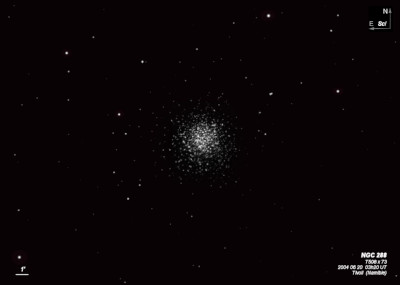
15x50 (8/25/06): easily visible in IS binoculars as a fairly large, diffuse glow.
William Herschel discovered NGC 288 = H VI-20 = h74 = h2354 on 27 Oct 1785 (sweep 467) and recorded "pB, L, oval round, bM, 7 or 8' long, 4 or 5' br." His summary description (including a 2nd observation) reads "cB, iR, 8 or 9' diameter, a great many of the stars visible, so that there can remain no doubt but that it is a cluster of vS stars." Caroline Herschel missed this cluster two years earlier when she discovered NGC 253. JH observed this globular both at Slough and at the Cape, where he recorded "globular cluster; bright; large; round; gradually brighter in the middle; all resolved into stars 12..16 mag; 5' diameter."
200/250mm - 8" (10/13/81): faint stars resolved across entire disc at 200x with averted, many near visual limit
8" (10/4/80): very large, grainy, few stars resolved at the NW and south edges, other clumps on the verge of resolution.
300/350mm - 13.1" (11/5/83): 30-40 stars resolved over haze.
400/500mm - 17.5" (8/29/92): very bright, very large, round, ~8' diameter. Well-resolved over entire disc into 75-100 stars mag 13-15 at White Mountains over background glow although not densely packed. 60 stars were resolved in a previous observation, only weakly concentrated in core.
600/800mm - 30" (10/15/15 - OzSky): this very loose globular appeared fully resolved at 303x. There were too many stars to possibly count, but certainly several hundred were resolved including a number of relatively bright stars (brightest members mag 12.6). The core was loosely overlaid with a dozen or so brighter stars. A number of stars in the halo appeared to be arranged in strings and arcs including one string extending towards the west.
Notes by Steve Gottlieb